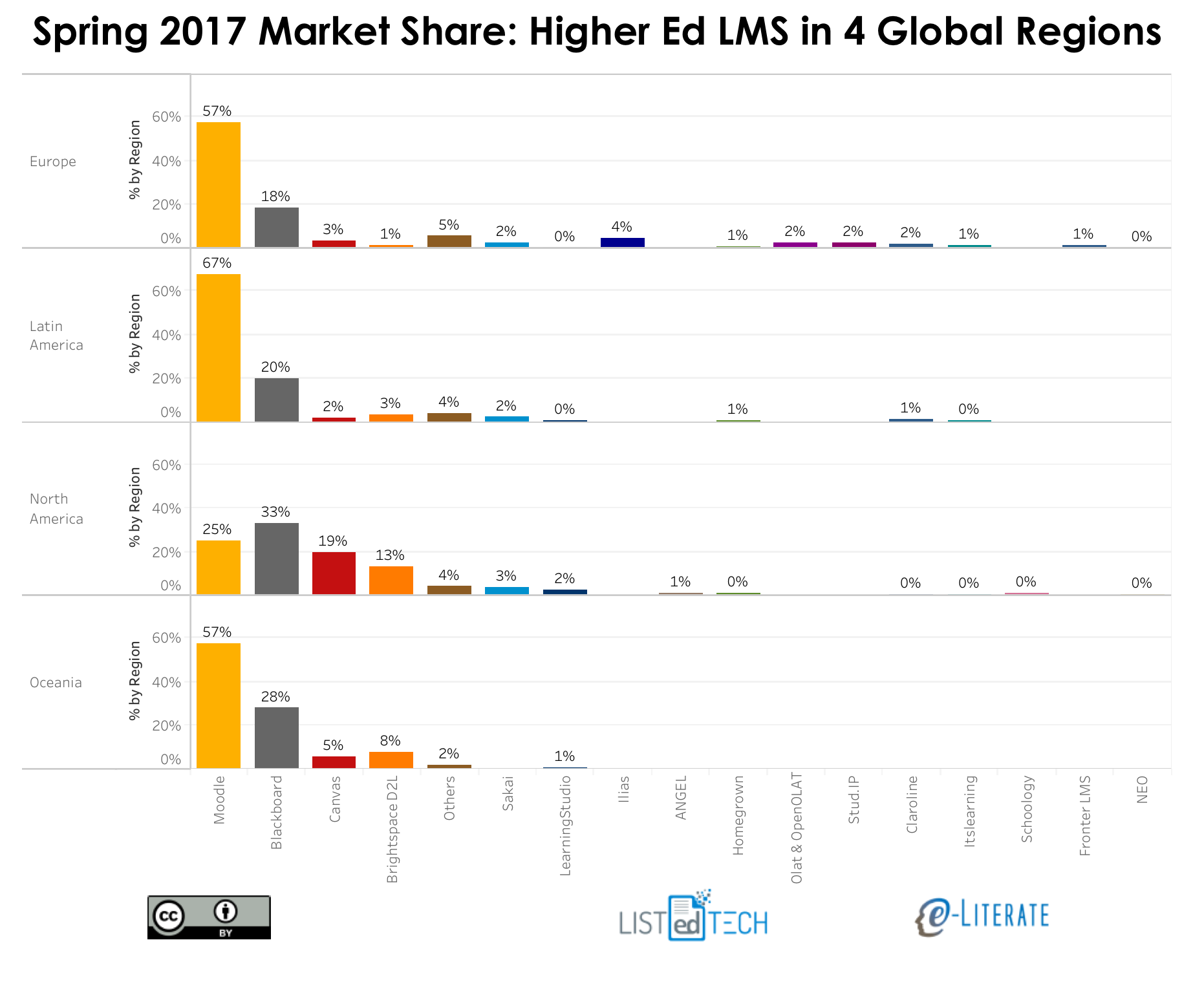In much of our coverage of the LMS market as well as media stories, there is a natural tendency to focus on change. Institution x abandons LMS y and adopts LMS z. In our recent post on Moodle, I described the trajectory of Moodle, noting that “the data seem to indicate a collapse of Moodle selections in the US and Canada, and potentially a significant slow-down in other regions”.
But we need to be careful to not lose perspective and miss the installed base of LMS customers. While there has market share information for US higher ed available for years, we can now share the broadest description of LMS market share in higher education. The view below, originally shared with subscribers to our LMS market analysis service, shows market share as the percentage of primary systems at degree-granting institutions for each of four global regions: North America (US and Canada), Europe, Latin America, and Oceania (Australia, New Zealand and surrounding island countries).
Thanks as always to our partners at LISTedTECH for the data and visualizations.
What is most striking to me is that across the globe we essentially have had a duopoly in this market – Moodle and Blackboard Learn. North America is the only region where a third-place solution (Canvas) or fourth-place (D2L), comes close to these two systems in market share. And Canvas only recently began its push into international markets. Put simply, Moodle and Blackboard own the lion’s share of academic LMS usage for higher education for all four global regions we currently track.
Additional Notes
- From a regional perspective, North America is the only region that is not truly a duopoly. There are four vendors in that region who have 90% of the market share.
- At the same time, Europe has the largest number of long-tail systems. Sakai, Ilias, Olat, Stud.IP, Claroline, itsLearning, and Fronter are all second-tier competitors (although our data shows virtually no new implementations for these systems – see this report for more details).
- While I have seen plenty of coverage about Moodle’s global footprint, what is less known is just how strong Blackboard Learn’s market position is internationally. And this view doesn’t even cover one of Blackboard’s biggest clients in Saudi Arabia, a nationwide deal.
- There has been a lot of investor interest in Instructure since they went public almost two years ago. Depending on your perspective, Canvas either has a long way to go to join Moodle and Blackboard as overall market leaders, or Canvas has a tremendous amount of headroom to continue its growth both in North America and in international regions.
- While not discussed as frequently in LMS market coverage, D2L ranks third in Oceania and Latin America market share and fourth in North America.
- It will be interesting at the users conferences for Moodle (MoodleMoot in the US), Blackboard, D2L and Instructure to see how much these providers share information about their global presence.
Yes, there is a lot of change occurring in the market with Canvas growing the fastest and D2L Brightspace securing key wins in the past year. But this view of installed base should augment the change-based coverage and provide a broader view to understand the general situation of academic LMS usage for higher ed.

I am building a small online English language center for business people in Asia who will soon travel overseas. I looked at Moodle because it is popular, etc. But I found it cumbersome to actually create lessons in it. And it is ugly and dated out of the box.. Sakai is fresh and clean, super easy to create lessons, but it has a small community, and does not seem very actively maintained.
I also saw Canvas was the fastest growing, so I checked into it next. Fresh and clean, super easy to use. Good docs, active community. BANG! This is the one for me!
YMMV, of course..
Robert, we hope to see you in our Community again soon–and frequently thereafter! You can always post a question in our Find Answers space when you need help. And “follow” some of the movers and shakers in the Community to learn about the innovative ways they’ve discovered to use Canvas!
I would like to see data that compares the LMSes by adding up the numbers of students at these same schools, who thereby become potential users of each platform. Unless I’m missing something, by this method of measurement a school with 300 students counts as much as a university with 40,000. Counting students would require a more effort than counting schools, but would be disproportionally more informative.